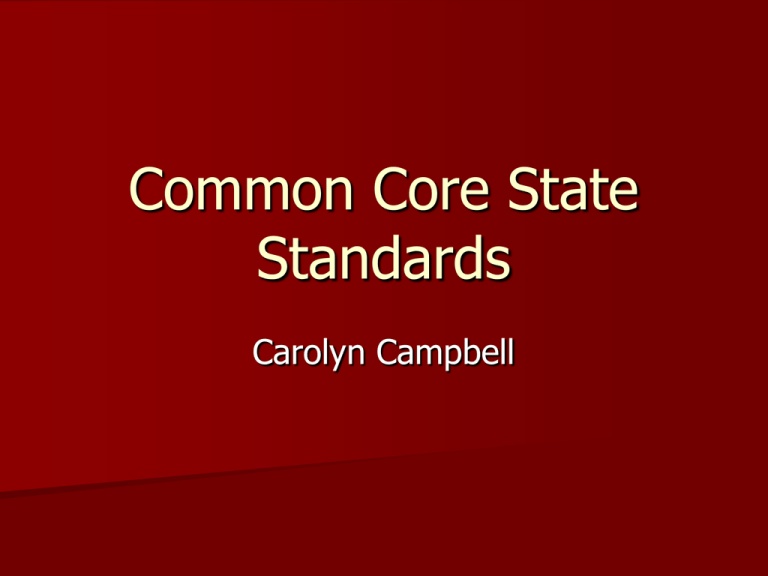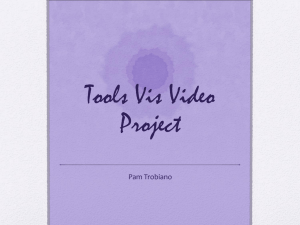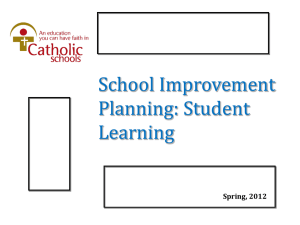Common Core State Standards PowerPoint
advertisement

Common Core State Standards Carolyn Campbell Common Core State Standards The controversy surrounding the Common Core State Standards (CCSS) has been of great interest to me. Therefore, I have taken on the task of determining if the CCSS are a viable option for my school. Literature Review Author: SHENINGER, ERIC. Source: Sheninger, Eric. (2013). Shifts and issues associated with the common core. Technology & Learning, 33(6), 30. Document Type: Article Abstract: The purpose of this article geared to two facilitators sharing input from educators in four states about the standards and the assistance needed to integrate common core into schools and classrooms during the 2012 ASCD Annual Conference. Case studies reveal about 50 percent of educators in Arkansas felt they did not have the resources and tools necessary to successfully implement the common core standards. Their biggest concern was the technological capacity to teach and assess students when there is no money to purchase what is needed to meet the expectations that come along with the assessment. Literature Review - SHENINGER continued 45 percent of the educators in North Carolina feel they do not have the resources and tools necessary to successful implement the common core state standards. Utah teachers were concerned about the availability of professional development offerings. To summarize, “successful transition to the common core hinges on the amount of support that schools will receive from states (if any) and quality professional development opportunities”. “As long as this issue and others discussed persist, resentment for the common core initiative will continue to grow” (Sheninger, 2013, p. 30). Literature Review Author: LOVELESS, T. Source: Loveless, T. (2012). He common core initiative: what are the chances of success?. Educational Leadership, (70(4), 60-63. Document Type: Article/Commentary Abstract: The purpose of this commentary is what the chances of success of the common core are. Loveless attempted to estimate the probability that the common core standards will produce more learning. She determined a good way to predict the future effects was to examine how well similar policies have worked in the past by examining the past effects of the state education standards. Loveless covered three areas in her original study. Initially, the writer looked at whether the quality of state standards is related to past gains in student achievement. Second, Loveless look at whether the levels at which states set past proficiency standards made a difference in achievement. Literature Review - LOVELESS continued Finally, the author looked at variation in achievement. On the basis of the findings, the most reasonable prediction is that the common core initiative will have little to no effect on student achievement. Loveless went on to say “There’s an important lesson here for educators who, in coming years, will be bombarded with tales of wonderful professional development tied to the common core standards. Be on guard” (Loveless, 2012). In closing, “The most reasonable prediction is that the Common Core initiative will have little to no effect on student achievement. Moreover, on the basis of current research, high-quality professional development and “excellent” curricular materials are also unlikely to boost the common core standards’ slim chances of success”. Literature Review Author: EILERS, L. H., & D’AMICO, M. Source: Eilers, L. H., & D’Amico, M. (2012). Essential leadership elements in implementing common core state standards. Delta Kappa Gamma Bulletin, 78(4), 46-50. Document Type: Article Abstract: The purpose of this article is to explain the six essential elements in implementing common core state standards. The six elements are a clear purpose, priorities, alignment, professional discourse, risk taking, and feedback. The CCSSI sets standards for learning to ensure that all students in U.S. Schools are ready for college and the workplace. The CCSSI poses an additional challenge of not providing a blueprint for leaders. Rather, the school leaders are required to chart and modify the course as needed, identify the vessels for the journey, and keep everyone on board throughout the voyage. “Only skilled and principled leaders will facilitate the necessary changes in school personnel and climate required to establish more rigorous and robust schools. School leaders who embrace these elements will be better equipped to move their colleagues from current beliefs and practices to new and uncharted territory”. Literature Review Author: BELL, J. & THATCHER, D. Source: Bell, J., & Thatcher, D. (2012). Challenged to the core. State Legislatures, 38(8), 1317. Document Type: Article Abstract: The purpose of this article is to decide if the common core is either one of the most significant state education reforms ever or just another short-term fix. The common core state standards (CCSS) fully adopted by 45 states now place legislatures squarely in the middle of the most important next step. They must decide which reforms and laws are necessary to meet the initiatives’ requirements. To date, all but Alaska, Nebraska, Texas and Virginia have adopted the new standards. Even though the standards were developed at the state level, some policymakers are concerned the federal government will insert its influence into the project, causing states and localities to lose some control over education and their state standards. Wisconsin’s Senator Olsen states “I’m concerned that by trying to do everything at once we are going to implode, especially when state legislators have not been a part to this from the beginning”. The United Sates is currently ranked 17th in reading and math world-wide. Literature Review Author: YATVIN, J. Source: Yatvin, J. 2013). Warning: the common core standards may be harmful to children. Phi Delta Kappan, 94(6), 42-44. Document Type: Article Abstract: The purpose of this article is to ascertain whether the language arts standards of the common core in too many places are simply too difficult and/or irrelevant for elementary grade students. Ms. Yatvin states “I have read the English/language arts (ELA) standards many times; each time, they are more troubling. Some standards call on young children to behave like high school seniors, making fine distinctions between words or literary devices, carrying on multiple processes simultaneously, and expressing their understandings in precise academic language”. The article gives several scenarios on why the CCSS aren’t suitable for elementary aged children. The author concluded “The reality is that the standards’ creators have laid out a set of expectations for America’s children that are grounded only in an antiquated conception of education and their personal preferences”. Analyzing, organizing, and reporting the literature and research groups I continue to do research. New developments continue to happen as late as today in other states who have adopted and now trying to get out from under the common core. I will dissect these articles I will organize and report the literature. My research group consists of quantitative and qualitative research. At such time as the Nebraska Department of Education adopts or rejects the CCSS, a research group is premature. Statement of Ethical Considerations I will take great care in the proper use of citations, credits, etc., in my study. At this time, I do not intend to use blogs unless they are authored by experts in the field of education. Data Analysis Through the words I have read and the research I have done, I will compile and analyze the data to form an educational opinion as to impact the common core state standards will have in my school. The true test of my work won’t be revealed until such time as the Nebraska Department of Education accepts or rejects the adoption of the common core state standards. At that time, assessments will clarify the study. Data Collection My data analysis will consist of quantitative research as well as qualitative research completed in the area of the common core state standards. I have gathered a variety of research from numerous sources dealing with both the positive and the negative aspects of the common core in different states, different schools, and different demographics. Through the words I have read and the research I have done, I will compile and analyze the data to form an educational opinion as to impact the common core state standards will have in my school. The true test of my work won’t be revealed until such time as the Nebraska Department of Education accepts or rejects the adoption of the common core state standards. At that time, assessments will clarify the study. References Baule, S. M. (2013). With common core and NCLB, are we missing the point? Technology & Learning, 33(6), 32. Bell, J., & Thatcher, D. (2012). Challenged to the core. State Legislatures, 38(8), 13-17. Eilers, L. H., & D’Amico, M. (2012). Essential leadership elements in implementing common core state standards. Delta Kappa Gamma Bulletin, 78(4), 46-50. Greene, K. (2012). Common core: Fact or fiction. Instructor, 122(2), 23-27. Eubanks, S. ,. E. A. ,. National Education Association, NEA Education Policy and Practice Department. (2013). Nea common core state standards toolkit (10933-2013). Washington, D.C.: National Education Association. Guliano, J. A. (2013, June 01). Battle lines drawn over common core standards. GoLocalProv. Retrieved from http://www.golocalprov References - Continued Guilfoile, L., & Ryan, M. (2013). Education Commission of the States, (April, 2013). Linking service- learning and the common core state standards: alignment, progress, and obstacles. Retrieved from National Center for Learning and Leadership website: http://www.ecs.org Katzman, J. (2012). Putting the schools in charge. Education Digest, 78(4), 37-47. Loveless, T. (2012). The common core initiative: What are the chances of success?. Educational Leadership, 70(4), 60-63.






